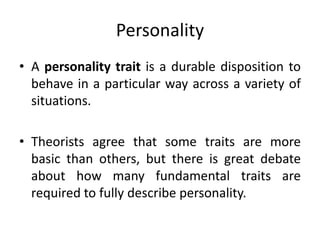
Freud's Psychoanalytic Theory of Personality Structure
- 1. Personality • A personality trait is a durable disposition to behave in a particular way across a variety of situations. • Theorists agree that some traits are more basic than others, but there is great debate about how many fundamental traits are required to fully describe personality.
- 2. Sigmund Freud’s theory • Sigmund Freud’s psychoanalytic theory grew out of his therapeutic work with clients and emphasized the importance of the unconscious • Freud divided personality structure into three components: the id, ego and superego. • The id is the instinctive component that follows the pleasure principle, the ego is the decision making component that follows the reality principle and the superego is the moral component that follows the morality principle.
- 3. ID – EGO - SUPEREGO • Id - One of the three components of the psyche, it is responsible for instinctual urges and is completely unconscious. • Ego - One of the three components of the psyche, it is the part of the psyche that deals with reality. • Superego - One of the three components of the psyche, the super-ego represents internalized social rules. It is partly conscious, and it enforces rules and imposes guilt. • Libido - Psychic energy derived from the sex drive.
- 4. Levels of consciousness • Freud described three levels of awareness: the conscious (current awareness), the preconscious (material just below the level of awareness) and the unconscious (material well below the surface of awareness).
- 8. The Structure of Personality ID EGO SUPEREGO
- 9. Id operate according to pleasure principles Id: Innate biological instincts and urges; self-serving & irrational place ;Totally unconscious Works on Pleasure Principle: Wishes to have its desires (pleasurable) satisfied , without waiting and regardless of the consequences(immediate gratification ) NOW
- 10. The Structure of Personality The Ego- Executive of Personality The part of the mind that constrains the id to reality Develops around 2-3 years of age Mediates between id, superego, and environment
- 11. EGO Operates according to the reality principle and secondary process thinking Reality principle ; Mediate between demand of reality and Id Secondary process Involve thinking process ,action and delay the immediate gratification or demands of id ..
- 12. The Structure of Personality The Superego- Upholder of Values and Ideals(guilt oriented part) The part of the mind that internalizes the values, morals, and ideals of society and religion Develops around age 3 to 4 Not bound by reality
- 13. Conflicts id Ego (conflict) id vs superego Superego
- 15. Freud proposed that children evolve through five stages of psychosexual development: the oral, anal, phallic, latency and genital stages. Certain experiences during these stages such as the handling of the Oedipus complex and electra complex can shape subsequent adult personality.
- 16. Crisis of this stage Oedipus complex ….BOYS Electra complex …GIRLS
- 17. 17 Oedipus Complex A boy’s sexual desire for his mother and feelings of jealousy and hatred for the rival father. A girl’s desire for her father is called the Electra complex.
- 18. Oedipus Complex A boy’s sexual feeling for his mother and rivalries with his father Psychological defenses against these threatening thoughts and feelings Form reaction pattern used throughout life Form personality through identification with father Diminish fear of castration-vicariously obtain mother through father
- 19. Stages of Personality development Freud noted that, at different times in our lives, different parts of our skin give us greatest pleasure. Later theorists would call these areas erogenous zones. Oral 0 -1/2 years Weaning Anal 2 – 3/4 years Toilet training Phallic 4 – 5/6 years Identifying Latency 6 – 12/13 years Transforming Genital 13 + Love / Work
- 21. Behavioural perspectives Burrhus Frederick Skinner’s theory • Work on operant conditioning • Personality development: shaped by reinforcement Albert Bandura’s theory • Social learning theory • Role of self efficacy
- 22. Skinner’s theory B.F.Skinner’s work on Operant conditioning was not meant to be a theory of personality but it has been applied to personality Skinner’s followers view personality as a collection of response tendencies that are tied to specific situations Skinnerians view personality development as a lifelong process in which response tendencies are shaped by reinforcement
- 23. Bandura’s theory Albert Bandura’s social learning theory emphasizes how cognitive factors shape personality According to Bandura people’s response tendencies are largely acquired by observational learning. Bandura stressed the role of self efficacy – one’s belief about one’s ability to perform behaviours that should lead to expected outcomes Greater self efficacy is associated with greater success in a variety of athletic, academic and health pursuits.
- 24. Maslow’s theory Abraham Maslow proposed that human motives are organized into a hierarchy of needs in which basic needs must be met before less basic needs are aroused.